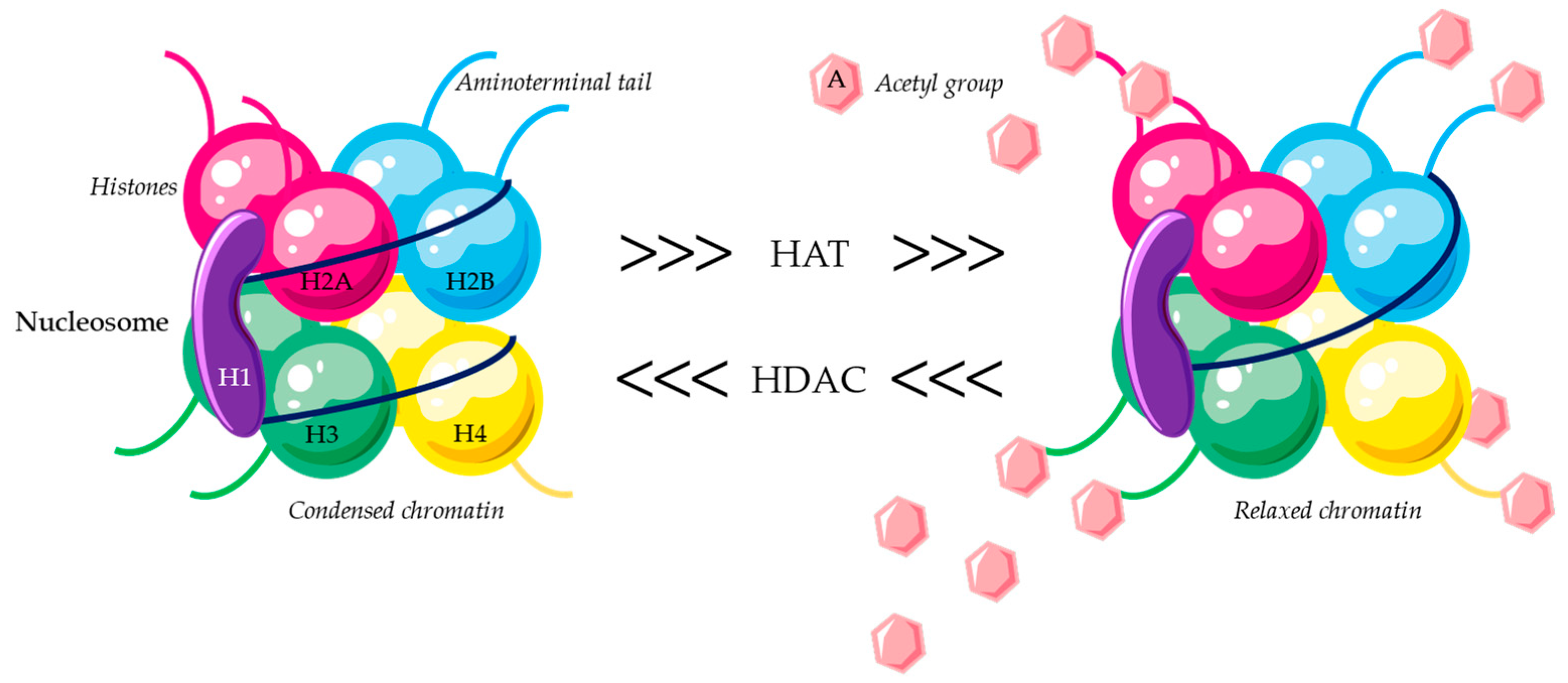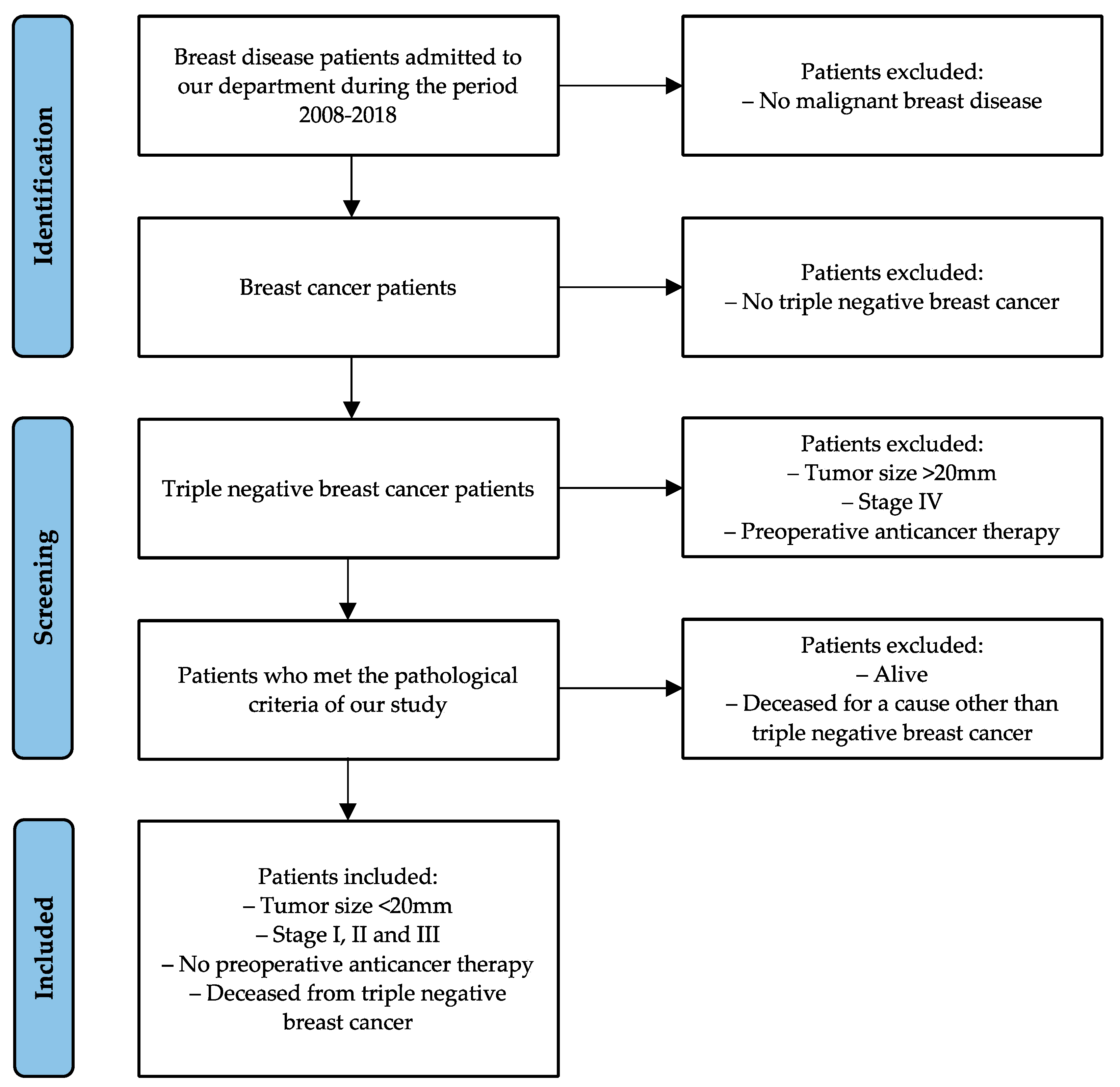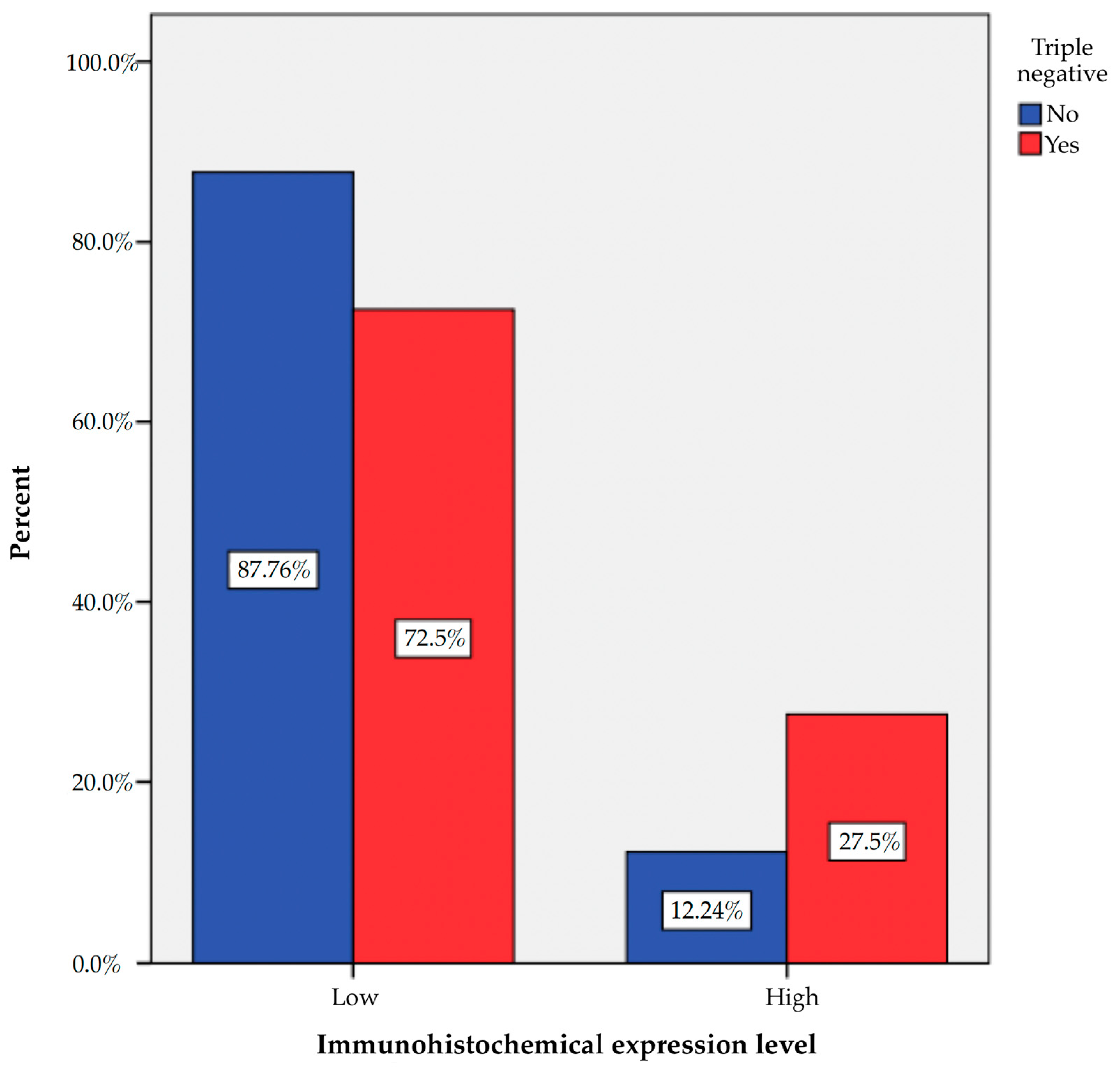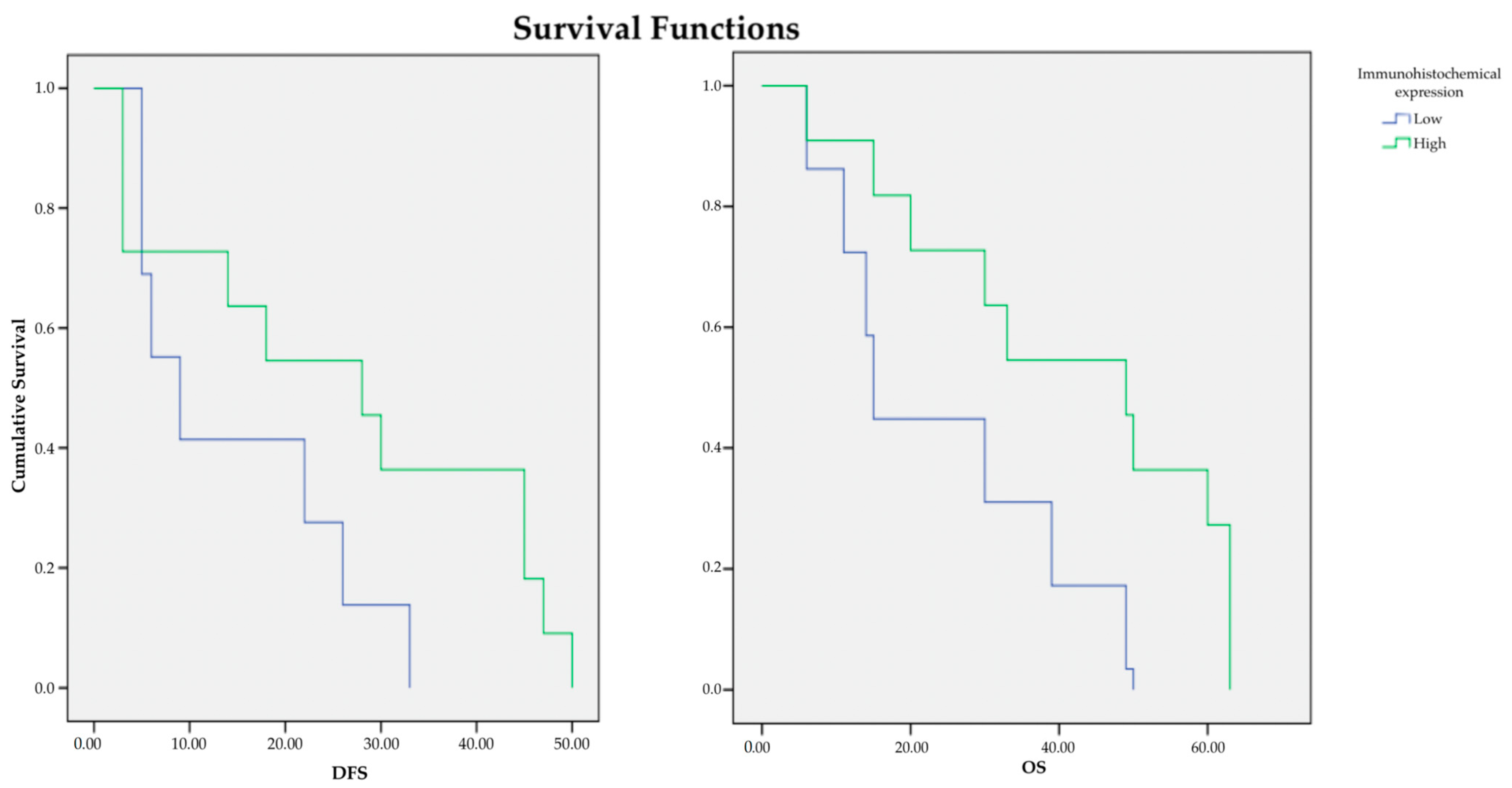Evaluation of the Histone Deacetylase 2 (HDAC-2) Expression in Human Breast Cancer
Abstract
Simple Summary
Abstract
1. Introduction
2. Materials and Methods
2.1. Clinical Material
2.2. Immunohistochemistry
2.3. Evaluation of Immunohistochemistry
2.4. Statistical Analysis
3. Results
4. Discussion
5. Conclusions
Author Contributions
Funding
Institutional Review Board Statement
Informed Consent Statement
Data Availability Statement
Conflicts of Interest
References
- American Cancer Society. Key Statistics for Breast Cancer: American Cancer Society; American Cancer Society: Atlanta, GA, USA, 2022. [Google Scholar]
- Elias, A.D. Triple-negative breast cancer: A short review. Am. J. Clin. Oncol. 2010, 33, 637–645. [Google Scholar] [CrossRef] [PubMed]
- Dass, S.A.; Tan, K.L.; Selva Rajan, R.; Mokhtar, N.F.; Mohd Adzmi, E.R.; Wan Abdul Rahman, W.F.; Tengku Din, T.A.D.A.; Balakrishnan, V. Triple negative breast cancer: A review of present and future diagnostic modalities. Medicina 2021, 57, 62. [Google Scholar] [CrossRef] [PubMed]
- American Cancer Society. Triple Negative Breast Cancer: American Cancer Society; American Cancer Society: Atlanta, GA, USA, 2022. [Google Scholar]
- Yang, R.; Li, Y.; Wang, H.; Qin, T.; Yin, X.; Ma, X. Therapeutic progress and challenges for triple negative breast cancer: Targeted therapy and immunotherapy. Mol. Biomed. 2022, 3, 8. [Google Scholar] [CrossRef] [PubMed]
- Boyle, P. Triple-negative breast cancer: Epidemiological considerations and recommendations. Ann. Oncol. 2012, 23 (Suppl. S6), vi7–vi12. [Google Scholar] [CrossRef] [PubMed]
- Landry, I.; Sumbly, V.; Vest, M. Advancements in the treatment of triple-negative breast cancer: A narrative review of the literature. Cureus 2022, 14, e21970. [Google Scholar] [CrossRef] [PubMed]
- Luger, K.; Mader, A.W.; Richmond, R.K.; Sargent, D.F.; Richmond, T.J. Crystal structure of the nucleosome core particle at 2.8 A resolution. Nature 1997, 389, 251–260. [Google Scholar] [CrossRef]
- Davey, C.A.; Sargent, D.F.; Luger, K.; Maeder, A.W.; Richmond, T.J. Solvent mediated interactions in the structure of the nucleosome core particle at 1.9 a resolution. J. Mol. Biol. 2002, 319, 1097–1113. [Google Scholar] [CrossRef]
- Damaskos, C.; Garmpis, N.; Valsami, S.; Kontos, M.; Spartalis, E.; Kalampokas, T.; Kalampokas, E.; Athanasiou, A.; Moris, D.; Daskalopoulou, A.; et al. Histone deacetylase inhibitors: An attractive therapeutic strategy against breast cancer. Anticancer Res. 2017, 37, 35–46. [Google Scholar] [CrossRef]
- Felsenfeld, G. Chromatin as an essential part of the transcriptional mechanism. Nature 1992, 355, 219–224. [Google Scholar] [CrossRef]
- Wolffe, A.P. Transcription: In tune with the histones. Cell 1994, 77, 13–16. [Google Scholar] [CrossRef]
- Kouzarides, T. Chromatin modifications and their function. Cell 2007, 128, 693–705. [Google Scholar] [CrossRef] [PubMed]
- Garmpis, N.; Damaskos, C.; Dimitroulis, D.; Kouraklis, G.; Garmpi, A.; Sarantis, P.; Koustas, E.; Patsouras, A.; Psilopatis, I.; Antoniou, E.A.; et al. significance of the histone deacetylase 2 (HDAC-2) expression in human breast cancer. J. Pers. Med. 2022, 12, 1672. [Google Scholar] [CrossRef] [PubMed]
- McKenna, N.J.; O’Malley, B.W. Combinatorial control of gene expression by nuclear receptors and coregulators. Cell 2002, 108, 465–474. [Google Scholar] [CrossRef]
- Grunstein, M. Histone acetylation in chromatin structure and transcription. Nature 1997, 389, 349–352. [Google Scholar] [CrossRef] [PubMed]
- Marks, P.A.; Richon, V.M.; Rifkind, R.A. Histone deacetylase inhibitors: Inducers of differentiation or apoptosis of transformed cells. J. Natl. Cancer Inst. 2000, 92, 1210–1216. [Google Scholar] [CrossRef] [PubMed]
- Archer, S.Y.; Hodin, R.A. Histone acetylation and cancer. Curr. Opin. Genet. Dev. 1999, 9, 171–174. [Google Scholar] [CrossRef]
- Ropero, S.; Esteller, M. The role of histone deacetylases (HDACs) in human cancer. Mol. Oncol. 2007, 1, 19–25. [Google Scholar] [CrossRef]
- Psilopatis, I.; Garmpis, N.; Garmpi, A.; Vrettou, K.; Sarantis, P.; Koustas, E.; Antoniou, E.A.; Dimitroulis, D.; Kouraklis, G.; Karamouzis, M.V.; et al. The Emerging Role of Histone Deacetylase Inhibitors in Cervical Cancer Therapy. Cancers 2023, 15, 2222. [Google Scholar] [CrossRef]
- Li, Y.; Seto, E. HDACs and HDAC inhibitors in cancer development and therapy. Cold Spring Harb. Perspect. Med. 2016, 6, a026831. [Google Scholar] [CrossRef]
- Xu, P.; Xiong, W.; Lin, Y.; Fan, L.; Pan, H.; Li, Y. Histone deacetylase 2 knockout suppresses immune escape of triple-negative breast cancer cells via downregulating PD-L1 expression. Cell Death Dis. 2021, 12, 779. [Google Scholar] [CrossRef]
- Xie, Y.; Shi, Z.; Qian, Y.; Jiang, C.; Liu, W.; Liu, B.; Jiang, B. HDAC2- and EZH2-mediated histone modifications induce PDK1 expression through miR-148a downregulation in breast cancer progression and adriamycin resistance. Cancers 2022, 14, 3600. [Google Scholar] [CrossRef] [PubMed]
- Huang, W.; Chen, J.; Liu, X.; Liu, X.; Duan, S.; Chen, L.; Liu, X.; Lan, J.; Zou, Y.; Guo, D.; et al. MIER3 induces epithelial-mesenchymal transition and promotes breast cancer cell aggressiveness via forming a co-repressor complex with HDAC1/HDAC2/Snail. Exp. Cell Res. 2021, 406, 112722. [Google Scholar] [CrossRef] [PubMed]
- Darvishi, N.; Rahimi, K.; Mansouri, K.; Fathi, F.; Menbari, M.N.; Mohammadi, G.; Abdi, M. MiR-646 prevents proliferation and progression of human breast cancer cell lines by suppressing HDAC2 expression. Mol. Cell. Probes 2020, 53, 101649. [Google Scholar] [CrossRef] [PubMed]
- Zhang, Z.; Qiu, N.; Yin, J.; Zhang, J.; Liu, H.; Guo, W.; Liu, M.; Liu, T.; Chen, D.; Luo, K.; et al. SRGN crosstalks with YAP to maintain chemoresistance and stemness in breast cancer cells by modulating HDAC2 expression. Theranostics 2020, 10, 4290–4307. [Google Scholar] [CrossRef] [PubMed]
- Hu, Z.; Wei, F.; Su, Y.; Wang, Y.; Shen, Y.; Fang, Y.; Ding, J.; Chen, Y. Histone deacetylase inhibitors promote breast cancer metastasis by elevating NEDD9 expression. Signal Transduct. Target. Ther. 2023, 8, 11. [Google Scholar] [CrossRef]
- Kim, A.; Mo, K.; Kwon, H.; Choe, S.; Park, M.; Kwak, W.; Yoon, H. Epigenetic Regulation in Breast Cancer: Insights on Epidrugs. Epigenomes 2023, 7, 6. [Google Scholar] [CrossRef]
- Edge, S.B.; Compton, C.C. The American Joint Committee on cancer: The 7th edition of the AJCC cancer staging manual and the future of TNM. Ann. Surg. Oncol. 2010, 17, 1471–1474. [Google Scholar] [CrossRef]





| Class I | Class II | Class III | Class IV | ||
|---|---|---|---|---|---|
| A | B | ||||
| Classical | HDAC-1 HDAC-2 HDAC-3 HDAC-8 | HDAC-4 HDAC-5 HDAC-7 HDAC-9 | HDAC-6 HDAC-10 | HDAC-11 | |
| Sirtuins | SIRT-1 SIRT-2 SIRT-3 SIRT-4 SIRT-5 SIRT-6 SIRT-7 | ||||
| Clinicopathological Parameter | Mean Value | Standard Deviation (SD) |
|---|---|---|
| Patients Age | 67.3 | 10.8 |
| Tumor Diameter (mm) | 14.3 | 8.3 |
| Resection Margin (mm) | 0.6 | 1.1 |
| Ki67 | 38.0 | 21.1 |
| Tumor Samples (N) | Percent (%) | |
| Histological type Ductal Lobular | 36 4 | 90 10 |
| Grade 2 3 | 12 28 | 30 70 |
| p53 − + ++ +++ | 4 0 8 12 | 10 0 20 30 |
| Stage 0 I II III | 0 8 12 20 | 0 20 30 50 |
| Tissue Samples | Immunohistochemical Expression | |||
|---|---|---|---|---|
| Low | High | |||
| N | % | N | % | |
| Triple negative breast cancer | 29 | 72.5 | 11 | 27.5 |
| Non-triple negative breast cancer | 86 | 87.8 | 12 | 12.2 |
| Variables | 95% CI—HR | |||
|---|---|---|---|---|
| HR | Immunohistochemical Expression | p | ||
| Low | High | |||
| Age | 1.02 | 0.98 | 1.06 | 0.281 |
| Immunohistochemical expression | 0.19 | 0.05 | 0.72 | 0.014 |
| Grade (3 vs. 1–2) | 0.94 | 0.36 | 2.47 | 0.903 |
| Stage | 1.06 | 0.66 | 1.69 | 0.824 |
| Ki67 | 0.99 | 0.97 | 1.01 | 0.369 |
| Variables | 95% CI—HR | |||
|---|---|---|---|---|
| HR | Immunohistochemical Expression | p | ||
| Low | High | |||
| Age | 1.01 | 0.97 | 1.05 | 0.685 |
| Immunohistochemical expression | 0.26 | 0.08 | 0.78 | 0.017 |
| Grade (3 vs. 1–2) | 1.30 | 0.47 | 3.56 | 0.615 |
| Stage | 2.05 | 1.23 | 3.41 | 0.006 |
| Ki67 | 0.97 | 0.94 | 1.00 | 0.053 |
Disclaimer/Publisher’s Note: The statements, opinions and data contained in all publications are solely those of the individual author(s) and contributor(s) and not of MDPI and/or the editor(s). MDPI and/or the editor(s) disclaim responsibility for any injury to people or property resulting from any ideas, methods, instructions or products referred to in the content. |
© 2024 by the authors. Licensee MDPI, Basel, Switzerland. This article is an open access article distributed under the terms and conditions of the Creative Commons Attribution (CC BY) license (https://creativecommons.org/licenses/by/4.0/).
Share and Cite
Damaskos, C.; Psilopatis, I.; Garmpi, A.; Dimitroulis, D.; Nikolettos, K.; Vrettou, K.; Sarantis, P.; Koustas, E.; Kouraklis, G.; Antoniou, E.A.; et al. Evaluation of the Histone Deacetylase 2 (HDAC-2) Expression in Human Breast Cancer. Cancers 2024, 16, 209. https://doi.org/10.3390/cancers16010209
Damaskos C, Psilopatis I, Garmpi A, Dimitroulis D, Nikolettos K, Vrettou K, Sarantis P, Koustas E, Kouraklis G, Antoniou EA, et al. Evaluation of the Histone Deacetylase 2 (HDAC-2) Expression in Human Breast Cancer. Cancers. 2024; 16(1):209. https://doi.org/10.3390/cancers16010209
Chicago/Turabian StyleDamaskos, Christos, Iason Psilopatis, Anna Garmpi, Dimitrios Dimitroulis, Konstantinos Nikolettos, Kleio Vrettou, Panagiotis Sarantis, Evangelos Koustas, Gregory Kouraklis, Efstathios A. Antoniou, and et al. 2024. "Evaluation of the Histone Deacetylase 2 (HDAC-2) Expression in Human Breast Cancer" Cancers 16, no. 1: 209. https://doi.org/10.3390/cancers16010209
APA StyleDamaskos, C., Psilopatis, I., Garmpi, A., Dimitroulis, D., Nikolettos, K., Vrettou, K., Sarantis, P., Koustas, E., Kouraklis, G., Antoniou, E. A., Karamouzis, M. V., Nikolettos, N., Tsikouras, P., Marinos, G., Kontomanolis, E., Kontzoglou, K., & Garmpis, N. (2024). Evaluation of the Histone Deacetylase 2 (HDAC-2) Expression in Human Breast Cancer. Cancers, 16(1), 209. https://doi.org/10.3390/cancers16010209













